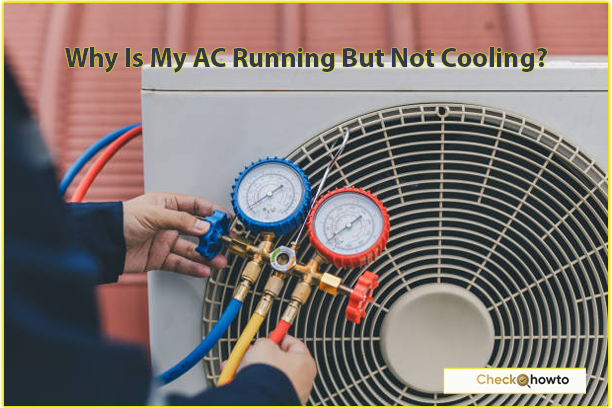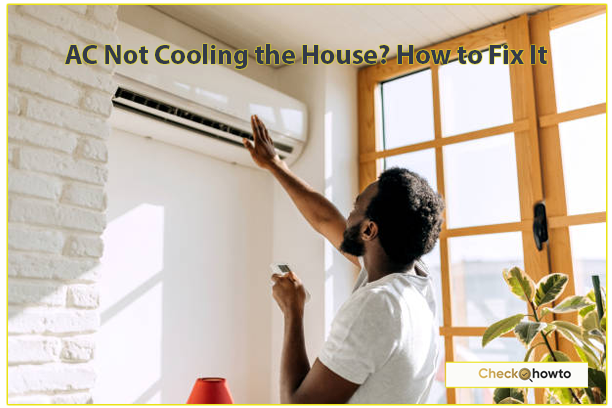When I first noticed that my AC was running but not cooling, I felt a wave of frustration. It’s one thing to have your air conditioner completely break down, but it’s another to have it running and yet fail to do its primary job of cooling your home or car. If you’re in the same boat, you’re probably wondering, “Why is my AC not cooling?” In this article, I’ll walk you through the possible reasons, how to diagnose them, and what you can do to fix the issue. Whether you’re a DIY enthusiast or just looking to understand the problem better, this guide will provide you with all the necessary details.

Related; AC Not Cooling the House? How to Fix It
How Does an AC Work?
Before diving into the reasons why your AC is not cooling, it’s essential to understand how an air conditioner works. Knowing the basics will help you better grasp the potential issues and solutions.
An air conditioner works by removing heat from your home and expelling it outside. It does this through a cycle of compression, condensation, expansion, and evaporation. The key components involved in this process are:
- Compressor: Compresses the refrigerant, raising its temperature.
- Condenser Coil: Releases the heat absorbed from your home to the outside air.
- Expansion Valve: Regulates the flow of refrigerant into the evaporator coil.
- Evaporator Coil: Absorbs heat from the indoor air, cooling it down.
When your AC is running but not cooling, it means that somewhere along this cycle, something is amiss. Let’s explore the possible reasons.
See; AC Not Cooling in Car? How to Fix it
Common Reasons Why Your AC Is Not Cooling
1. Dirty or Clogged Air Filters
One of the most common reasons your AC is not cooling is dirty or clogged air filters. When the air filters are clogged, they restrict airflow, making it difficult for the AC to cool your home effectively. I’ve experienced this firsthand, and it’s a simple fix.
What You Can Do:
- Check your air filters and replace them if they’re dirty.
- Make it a habit to check your filters every month, especially during peak usage seasons.
2. Low Refrigerant Levels
Refrigerant is the lifeblood of your AC system. If your AC is low on refrigerant, it won’t be able to absorb and expel heat effectively, leading to poor cooling performance. Low refrigerant levels are often due to leaks in the system.
What You Can Do:
- If you suspect a refrigerant leak, it’s best to call a professional. Handling refrigerant requires specialized knowledge and equipment.
3. Frozen Evaporator Coil
A frozen evaporator coil is another common issue that can cause your AC to run but not cool. This usually happens when there’s restricted airflow or low refrigerant levels.
What You Can Do:
- Turn off your AC and let the coil thaw.
- Check for and replace dirty air filters.
- If the problem persists, call a professional to check for refrigerant leaks or other issues.
4. Dirty Condenser Coil
The condenser coil is responsible for releasing heat from your home to the outside air. If it’s dirty or clogged, it can’t do its job effectively, leading to poor cooling performance.
What You Can Do:
- Turn off the power to your AC unit.
- Clean the condenser coil using a garden hose or a coil cleaner.
- Make sure to remove any debris around the unit that could obstruct airflow.
5. Thermostat Issues
Sometimes, the problem isn’t with the AC unit itself but with the thermostat. If your thermostat is not set correctly or is malfunctioning, it can cause your AC to run without cooling.
What You Can Do:
- Check the thermostat settings to ensure it’s set to “cool” and the temperature is set lower than the current room temperature.
- Replace the batteries if it’s a battery-operated thermostat.
- If you suspect a malfunction, consider replacing the thermostat.
6. Electrical Issues
Electrical problems, such as a tripped breaker or a blown fuse, can also cause your AC to run but not cool. These issues can prevent the compressor and fan from functioning correctly.
What You Can Do:
- Check your circuit breaker and reset it if necessary.
- Replace any blown fuses.
- If the problem persists, call a professional to inspect the electrical components.
7. Ductwork Issues
Leaky or poorly insulated ductwork can lead to significant cooling losses, making it seem like your AC is not cooling. If the cool air is escaping before it reaches your living spaces, your AC will have to work harder, leading to inefficiency.
What You Can Do:
- Inspect your ductwork for leaks or poor insulation.
- Seal any leaks with duct sealant or metal tape.
- Consider hiring a professional to assess and repair your ductwork.
8. Oversized or Undersized AC Unit
An AC unit that’s too large or too small for your home can lead to cooling issues. An oversized unit will cool your home too quickly, leading to short cycling, while an undersized unit will struggle to cool your home effectively.
What You Can Do:
- If you suspect your AC unit is not the right size, consult with an HVAC professional to determine the appropriate size for your home.
9. Blocked or Closed Vents
Blocked or closed vents can restrict airflow, making it difficult for your AC to cool your home effectively. I’ve made the mistake of closing vents in unused rooms, thinking it would save energy, only to realize it was causing my AC to work harder.
What You Can Do:
- Ensure all vents are open and unobstructed.
- Avoid closing too many vents, as it can lead to pressure imbalances in your ductwork.
10. Aging AC Unit
If your AC unit is old, it may not be as efficient as it once was. Over time, wear and tear can lead to decreased performance, making it harder for your AC to cool your home.
What You Can Do:
- If your AC unit is more than 10-15 years old, consider replacing it with a newer, more energy-efficient model.
Diagnosing the Problem: Step-by-Step Guide
Now that we’ve covered the common reasons why your AC is not cooling, let’s go through a step-by-step guide to help you diagnose the problem.
Step 1: Check the Thermostat
Start by checking your thermostat. Ensure it’s set to “cool” and that the temperature is set lower than the current room temperature. If the thermostat is battery-operated, replace the batteries.
Step 2: Inspect the Air Filters
Next, check your air filters. If they’re dirty or clogged, replace them. This is a simple fix that can often resolve the issue.
Step 3: Examine the Condenser Unit
Go outside and inspect the condenser unit. Make sure it’s free of debris and that the condenser coil is clean. If it’s dirty, clean it using a garden hose or a coil cleaner.
Step 4: Check for Ice on the Evaporator Coil
If you suspect a frozen evaporator coil, turn off your AC and let the coil thaw. Once it’s thawed, check for and replace dirty air filters. If the problem persists, call a professional.
Step 5: Inspect the Ductwork
If you have access to your ductwork, inspect it for leaks or poor insulation. Seal any leaks with duct sealant or metal tape.
Step 6: Check the Circuit Breaker
If your AC is not cooling, check your circuit breaker. If it’s tripped, reset it. If the problem persists, call a professional.
Step 7: Call a Professional
If you’ve gone through all these steps and your AC is still not cooling, it’s time to call a professional. They can diagnose and fix more complex issues, such as refrigerant leaks or electrical problems.
Preventive Maintenance: Keeping Your AC Running Smoothly
Preventive maintenance is key to ensuring your AC runs smoothly and efficiently. Here are some tips to help you keep your AC in top shape:
1. Regularly Replace Air Filters
As mentioned earlier, dirty or clogged air filters can restrict airflow, making it difficult for your AC to cool your home effectively. Make it a habit to check your filters every month and replace them as needed.
2. Clean the Condenser Coil
The condenser coil is responsible for releasing heat from your home to the outside air. If it’s dirty or clogged, it can’t do its job effectively. Clean the condenser coil at least once a year to ensure optimal performance.
3. Schedule Annual Maintenance
Scheduling annual maintenance with a professional HVAC technician can help catch potential issues before they become major problems. During a maintenance visit, the technician will inspect and clean your AC unit, check refrigerant levels, and ensure all components are functioning correctly.
4. Keep the Area Around the Condenser Unit Clear
Ensure the area around your condenser unit is free of debris, such as leaves, grass, and dirt. This will help maintain proper airflow and prevent the unit from overheating.
5. Check the Thermostat Regularly
Regularly check your thermostat to ensure it’s functioning correctly. If you notice any issues, such as inaccurate temperature readings or difficulty adjusting the settings, consider replacing the thermostat.
6. Inspect the Ductwork
Inspect your ductwork for leaks or poor insulation. Sealing any leaks and ensuring proper insulation can help improve your AC’s efficiency and cooling performance.
7. Upgrade to a Programmable Thermostat
Consider upgrading to a programmable thermostat if you haven’t already. A programmable thermostat allows you to set different temperatures for different times of the day, helping you save energy and maintain a comfortable indoor environment.
When to Call a Professional
While many AC issues can be resolved with simple DIY fixes, some problems require the expertise of a professional HVAC technician. Here are some situations where it’s best to call a professional:
1. Refrigerant Leaks
Handling refrigerant requires specialized knowledge and equipment. If you suspect a refrigerant leak, it’s best to call a professional to diagnose and fix the issue.
2. Electrical Issues
Electrical problems can be dangerous to handle on your own. If you suspect an electrical issue, such as a tripped breaker or a blown fuse, call a professional to inspect and repair the problem.
3. Frozen Evaporator Coil
If your evaporator coil is frozen and the issue persists after thawing and replacing dirty air filters, it’s best to call a professional. They can diagnose and fix the underlying issue, such as low refrigerant levels or restricted airflow.
4. Ductwork Issues
If you suspect issues with your ductwork, such as leaks or poor insulation, it’s best to call a professional. They can assess the situation and recommend the best course of action.
5. Aging AC Unit
If your AC unit is old and not cooling effectively, it may be time to consider a replacement. A professional HVAC technician can help you choose the right size and type of unit for your home.
Conclusion: Why Is My AC Not Cooling?
If your AC is running but not cooling, it can be frustrating and uncomfortable, especially during the hot summer months. However, by understanding the common reasons behind this issue and following the steps outlined in this guide, you can diagnose and fix the problem. Remember, preventive maintenance is key to keeping your AC running smoothly and efficiently. If you’re ever in doubt or the issue persists, don’t hesitate to call a professional HVAC technician.
By taking the time to understand your AC system and addressing issues promptly, you can ensure your home stays cool and comfortable all year round. Whether it’s replacing dirty air filters, cleaning the condenser coil, or scheduling annual maintenance, these small steps can make a big difference in your AC’s performance.
So, the next time you find yourself asking, “Why is my AC not cooling?” you’ll be well-equipped to find the answer and take the necessary steps to resolve the issue. Stay cool!



